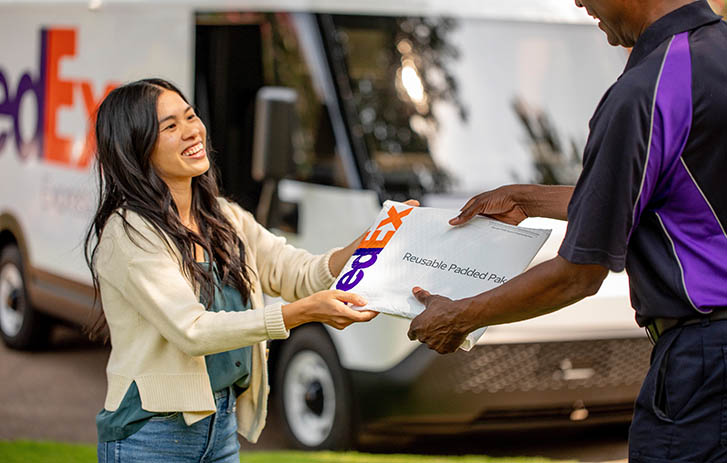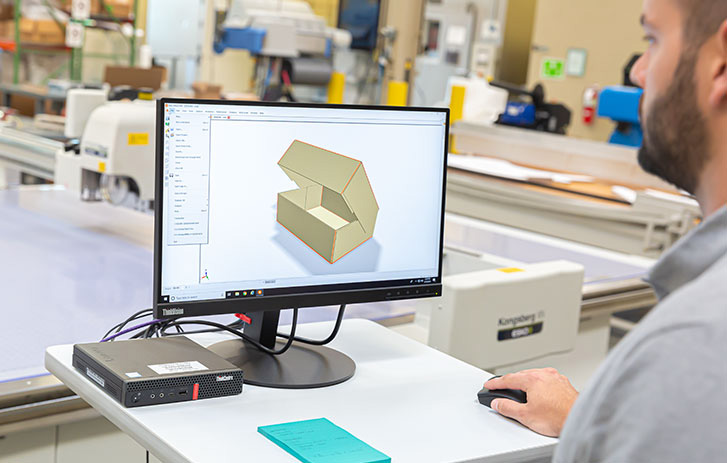
Sustainable packaging
Helping you pack your shipments
more responsibly
Here's what you'll find on this page:


















How is FedEx reducing the impact of packaging?
We deliver more than 15 million packages each business day. It’s our responsibility to extend our sustainability efforts to our packaging. Large-scale packaging innovation is only possible with intent and investment. That’s why we have a team of packaging engineers who are hard at work researching new packaging methods, materials, and manufacturing techniques. It’s how we'll keep delivering as we prioritize the planet.
Packaging is part of Priority Earth.
We’re committed to helping build a more sustainable future. The proof? Our goal to achieve carbon neutral operations by 2040. Priority Earth is our initiative to get there. Read about our plan—from rethinking packaging sustainability to upgrading vehicles to modernizing aircraft and more.
What is sustainable packaging?
Generally speaking, a sustainable package is one that protects the product, but uses only the necessary materials, and is designed with the environment in mind.



Packaging might
be considered
sustainable if it’s:



Product protective



Reusable



Curbside recyclable



Made with some recycled content



Made with optimal amount of material



Made from responsibly sourced material



Made using sustainable manufacturing processes






Balancing benefits with performance
Sustainable packaging needs to provide some benefit—like using less material or being reusable, for example—while still protecting the product from damage and loss. Some sustainable or recycled materials might offer a lot of sustainability benefits, but if the product is damaged in transit, those benefits could be lost.
Sustainable packaging options are evolving, and new materials are being introduced all the time. Creating and improving sustainable packaging is a process. And it’s one we’re embracing for the long haul. Contact our packaging lab for recommendations on making your packaging more sustainable.
Quick tips for packing more sustainably
Sustainable packing practices go beyond what materials you use. Check out our six easy-to-implement packing strategies that can help you boost sustainability, reduce damage, and build customer loyalty in the process.
Things to consider when choosing sustainable packaging
Finding the right sustainable packaging solution for your situation isn’t as simple as looking for the one with the highest recycled content or the lowest material weight. You have to consider how the packaging will perform and the impacts it will have on your business and your customers. Here are some key things to think about.
Right-size your packaging.
Obviously, you don’t want to ship in a giant box with excessive cushioning material. Not only does that translate to packaging waste, it also increases your shipping costs. Larger boxes mean fewer packages fit on pallets and trucks, and they waste space during storage, too. But don’t reduce packaging so much that you risk product damage, either. Which leads us to our next point…
Protect your product.
Packaging that fails to protect the product inside or doesn’t make it to the recipient can cause more environmental impacts than you might expect. You’re looking at the wasted initial packaging material, plus fuel and emissions during transport. And you’re also creating all those same wastes reshipping the replacement product. Not to mention the wasted energy and materials used to create the damaged one and the solid waste created by discarding it. So even though you chose sustainable packaging, the benefit was lost in the long run.
Take extra steps to avoid damage.
If you’re a business account holder, you can get free package testing from FedEx. Our experts can put your packaging through its paces to ensure it performs under pressure. We can even design packaging for you to maximize durability and protection.
Look at the bigger packaging picture.
When you’re trying to find a sustainable packaging solution, it’s tempting to make a big leap. For example, buying shipping boxes made from 100% recycled materials. But if they don’t protect the product, you’re risking damage.
Or if your packing tape and shipping labels don’t adhere well, packages could get lost in transit. (This is a genuine problem. In studies we conducted in the FedEx Packaging Lab, adhesives performed 50% worse on 100% recycled fiber surfaces. If you do go with 100% recycled, ask your supplier if your tapes and labels are compatible.)
Instead, you might consider buying packaging with slightly less recycled content from a supplier that sources responsibly. That supports responsible forestry while possibly reducing the waste associated with product damage.
Choose environmentally responsible packaging providers.
Here are some questions you can ask your suppliers to help find out if they prioritize environmental protection and sustainable packaging design.
- What are your sustainability goals and how are you working to meet them?
- Do you use recycled materials in your packaging?
- Are your packaging materials certified by any third parties?
- What sustainable manufacturing practices do you have in place?
- Have you done testing to prove the performance of your products?
Think critically about packaging options with the full life cycle in mind.
Let’s say you really like the idea of using compostable packaging. The problem? Most Americans don’t actively compost at home. And most products that are advertised as “compostable packaging” require commercial composting facilities anyway. Are your customers going to go to the trouble of taking your packaging to that facility? If not, it’s probably going in the trash.
Choosing traditional corrugated boxes might make more of an impact than compostable packaging, since more people are likely to recycle those at the curb. It’s important to do your research no matter which sustainable packaging solution you’re considering.
Corrugated is the most recycled packaging material. 96% of corrugated products made in 2018 were recycled.1
Packing lighter, protecting better
Learn how the FedEx Packaging Lab helped Liviri increase sustainability, protect products, and control temperature during shipment.
Prioritizing the planet through packaging
It’s our goal to help you ship as responsibly and sustainably as possible. That’s why we offer free FedEx Express® packaging options that are reusable, recyclable, and made from recycled content.



Reusable packaging for responsible shipping
Our reusable options include two adhesive sealing strips. Use the first strip to seal the package for the first trip. Your recipient can use the second to seal it again for a second trip. The first trip must use FedEx Express, but the second can use FedEx Express or FedEx Ground.
Meet our reusable packaging family
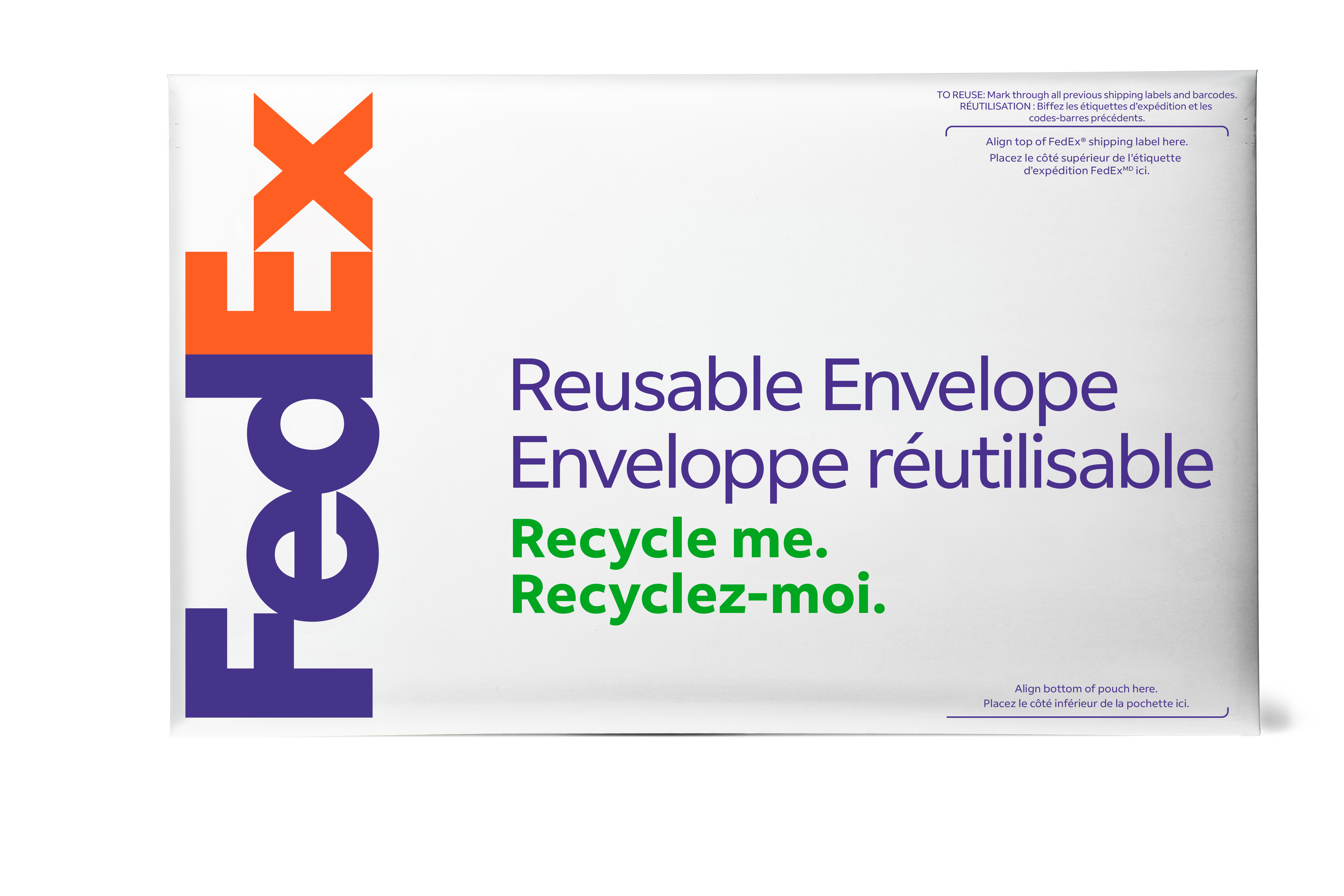


Reusable Envelope
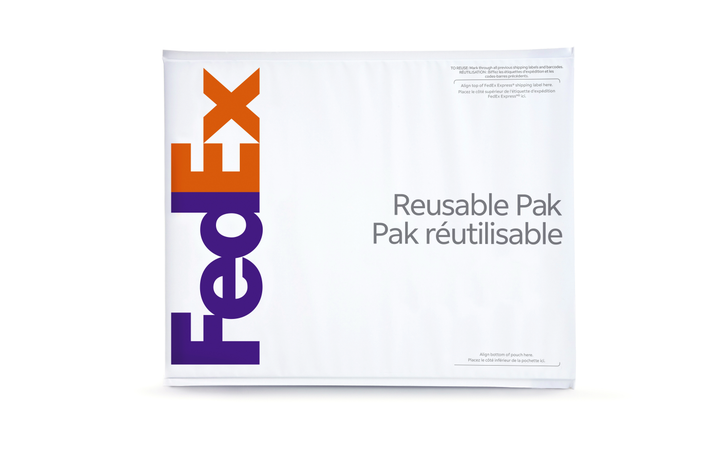


Reusable Pak
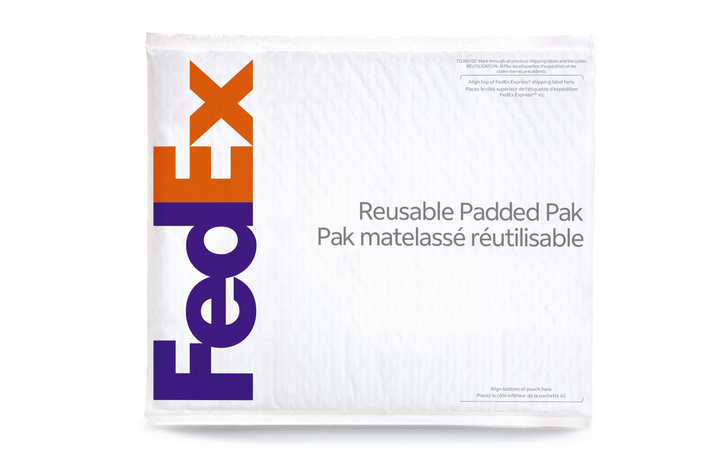


Reusable Padded Pak
We are on a journey toward a more sustainable future together — and FedEx is working to do its part. The FedEx Reusable Pak offers an opportunity to cut down on waste by allowing customers to easily return items or prepare their own shipments without additional packaging.
Did you know? Packaging that’s reusable can help make returns even
easier. Learn how easy returns can grow customer loyalty.
Did you know? Packaging that’s reusable can help make returns even easier. Learn how easy returns can grow customer loyalty.



Priority Earth: Working to deliver a more sustainable future
Our goal is to reach carbon neutral operations by 2040. Here's a look at our efforts in motion.
We are:
- Pledging $100 million to help establish the Yale Center for Natural Carbon Capture, where researchers will focus on ways to remove and store Earth’s excess carbon
Pledging $100 million to help establish the Yale Center for Natural Carbon Capture, where researchers will focus on ways to remove and store Earth’s excess carbon
- Continuing to invest in alternative fuels to reduce aircraft and vehicle emissions
Continuing to invest in alternative fuels to reduce aircraft and vehicle emissions
- Converting our entire parcel pickup and delivery fleet to zero-emission electric vehicles
Converting our entire parcel pickup and delivery fleet to zero-emission electric vehicles
- Investing in efficient facilities, renewable energy, and other energy management programs
Investing in efficient facilities, renewable energy, and other energy management programs
- Building on our FedEx® Fuel Sense initiatives to continue reducing aircraft fuel consumption
Building on our FedEx® Fuel Sense initiatives to continue reducing aircraft fuel consumption
Read more about our goal to reach carbon neutral operations by 2040 or take a
deeper dive into our sustainability story.
FAQs about sustainable packaging
Choosing the right sustainable packaging for your product requires balancing environmental benefits with packaging performance. You have to consider what you’re shipping, where it’s going, how it’s being transported, where it’s being stored, who will receive it, and what they’re likely to do with it once it arrives. All these factors will impact your decisions about the packaging material, the amount of protection it needs to offer, what environmental factors it needs to withstand, and more. A holistic look at the life cycle of your product and your packaging will help you choose the right packaging solution for your situation.
Sustainable packaging can take a lot of different forms. Generally, it’s packaging that doesn’t have a negative environmental impact, doesn’t create waste or pollution, or lives beyond the standard packaging life cycle—meaning it doesn’t go straight into the landfill. Examples are packaging that’s reusable, recyclable, made from recycled content, made with less material, or made from responsibly sourced material. Packaging industry experts are introducing sustainable packaging innovations all the time, using revolutionary substrates made from plant materials, fabrics, biodegradable plastic alternatives, recycled plastics, bio-based plastics, and other innovative materials.
The key is finding the sustainable packaging option that offers the right balance of price and performance. If you choose the least expensive option available but your products are damaged in transit, your savings and the environmental benefit are both lost. Consider what you’re packing and the transit scenario it will need to perform in, and choose the option that’s affordable and protective at the same time. To make sure your packaging will protect your products, contact our Packaging Lab about testing and design services.
Hot-melt adhesives work better than standard acrylic adhesives on recycled boxes because they bond well with the shorter corrugated box fibers of recycled content. To request our label developed specifically for recycled boxes, contact packagingservices@fedex.com. Or you can use a tire/crate label, which also contains a hot-melt adhesive. Learn more about how to create, print, and manage shipping labels.

